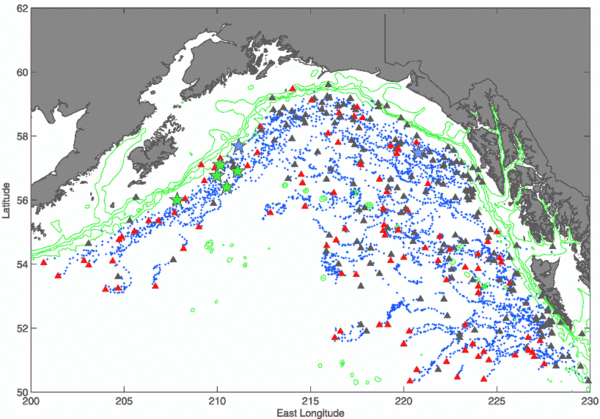Eddies in the Gulf of Alaska
Image of the Month - March 2010

Eddies are conveyors of many things in the ocean -- heat and nutrients among others. For a few years now mathematical techniques have been able to track and monitor these features in remotely sensed ocean datasets like sea surface height, in order to better understand their formation regions and transit pathways.
Gulf of Alaska's eddies tend to form in specific regions (for which they are later named), and move generally westward, along a corridor that runs parallel to the shelfbreak. Several warm eddies (anticyclonic eddies, seen as bumps on the sea level anomaly maps) are typically present at any given time in the Gulf of Alaska. These eddies form on or near the shelf, are about 80 to 200 km in diameter and extend to depths of 1500 m or below. Their core water is usually fresher, warmer, and more iron-rich than the ambient basin water in the same depth range.
Altimetry enables researchers to spot and monitor such ocean features. A better understanding of eddies, and their birth and movement, could improve our understanding the ocean. An interesting area of current research is investigating the role of these eddies in transporting and mixing iron from the shelf to basin, substantially enhancing regional biological production.

See also:
- Data: <link en data product-information duacs index.html _self internal-link>Ssalto/Duacs near-real and delayed time multimission altimeter products
- Image of the Month, June 2009: A corridor of eddies
- Image of the Month, Sep. 2007: <link en news idm sep-2007-altimetry-on-eddies-tracks index.html _self internal-link>Altimetry on eddies' tracks
- Lively data, September 18, 2008: Eddies in the Gulf of Alaska
Website on this subject:
- Graphic Images of the Haida Eddy (Fisheries and Oceans Canada)
- Tracking Eddies that Feed the Sea (Nasa Earth Observatory)
References:
- Rovegno, P. S., C. A. Edwards, and K. W. Bruland (2009), Observations of a Kenai Eddy and a Sitka Eddy in the Northern Gulf of Alaska, J. Geophys. Res., 114, C11012, doi:10.1029/2009JC005451.
- Henson, S. A., and A. C. Thomas (2008), A census of oceanic anticyclonic eddies in the Gulf of Alaska, Deep Sea Res. I, 55, 163– 176.




